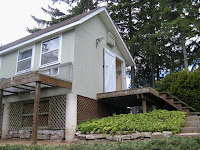Your pigeons will obviously need a place to stay and although you don’t have to build them a Columbarium (the Parthenon of pigeon lofts) you don’t want your pigeons living in a cardboard box either - and as stated in the last post on predators, it should be able to protect them. In this post, we will not only look at affordable housing options for your birds, but the history of pigeon living conditions from pre-domestication to modern times. Finally, I will post photographs from an actual loft that I visited myself.
Cro Pige-nons
What did the earliest modern human and pigeons have in common?
Hint: they are not called Rock Doves for nothing.
Above: Rock Dove in natural habitat on cliffs Hunstaton, Norfolk, UK. Copyright Andrew Dunn Creative Commons License.
Cro-Magnon man liked to make his home inside the rock shelter of Les Eyzies-de-Tayac-Sireuil in the southwest of France (amoung other places), the Rock Dove was fond of using cliff ledges along the coasts of Asia as you can see in the photo above.
Columbariums
The Columbaria was the name for the pigeon farms of ancient Rome. These rounded underground structures had their interior coated with white marble. Usually made out of limstone, it was possible to etch thousands of holes, which in one a mother to raise two squabs. Although the latin term is used, they actually originated in ancient Israel. You can see pictures of remains of these ancient structures here. It was the Romans that brought these structures to the conquered areas, including France (called pigeonnier or colombier).
Dovecotes
The earliest dovecotes were believed to be in Upper Egypt and Iran. Pigeon droppings were a hot commodity in these arid regions.
Loft Clothes and other precautions
When visiting the loft of my ‘Pigeon Liaisons’ Nick and Enna, they advised me if I ever visit a loft or have my own, to invest in a set of clothes for your loft, including shoes. Enna prefers a pair of Crocs, easy to slip on and easy to wash.
You should read up on biosecurity measures. If you are in Ontario, a package can be sent to you free of charge thanks to the Ontario Poultry Council.
How to Take Care of Your Loft
There is much to be said on this topic, but for a brief excellent overview you should consult with the Beginners Guide to Pigeon Racing available for download in .pdf format on the CRPU website.
DIY Loft -Red Rose Small Starter Loft
Not only is it fairly quick and easy to build (the site promises 1 weekend), it can be done for around $500. Best of all, the instructions are completely free and available on the website (click on links at bottom of the main page).
It also contains samples of various lofts from various pigeon racers.
I recently visited the loft of my Pigeon Racing Liaisons Nick and Enna. It is quite a nice loft, and fairly large. It is about as big as a small house. Its sits on top of a hill overlooking their home. The entrance is to the right in the photo, as you can see in the image below, you have to walk up a flight and a half of stairs to reach it, making it fairly predator proof.
The aviary is attached to the garage of their house. I was standing on the hill in front of the loft when I took this picture.
Below, the aviary up close.
Nesting Boxes:
Typical feeding tray up close and sneakers of the Future Champion Flyer.
 Ventilation system - next to predator proofing, getting adequate air circulating through your loft is of the up most importance.
Ventilation system - next to predator proofing, getting adequate air circulating through your loft is of the up most importance. Coming Soon - Is it a Pigeon, or is it Superman? The extraordinary abilities of Pigeons.








































